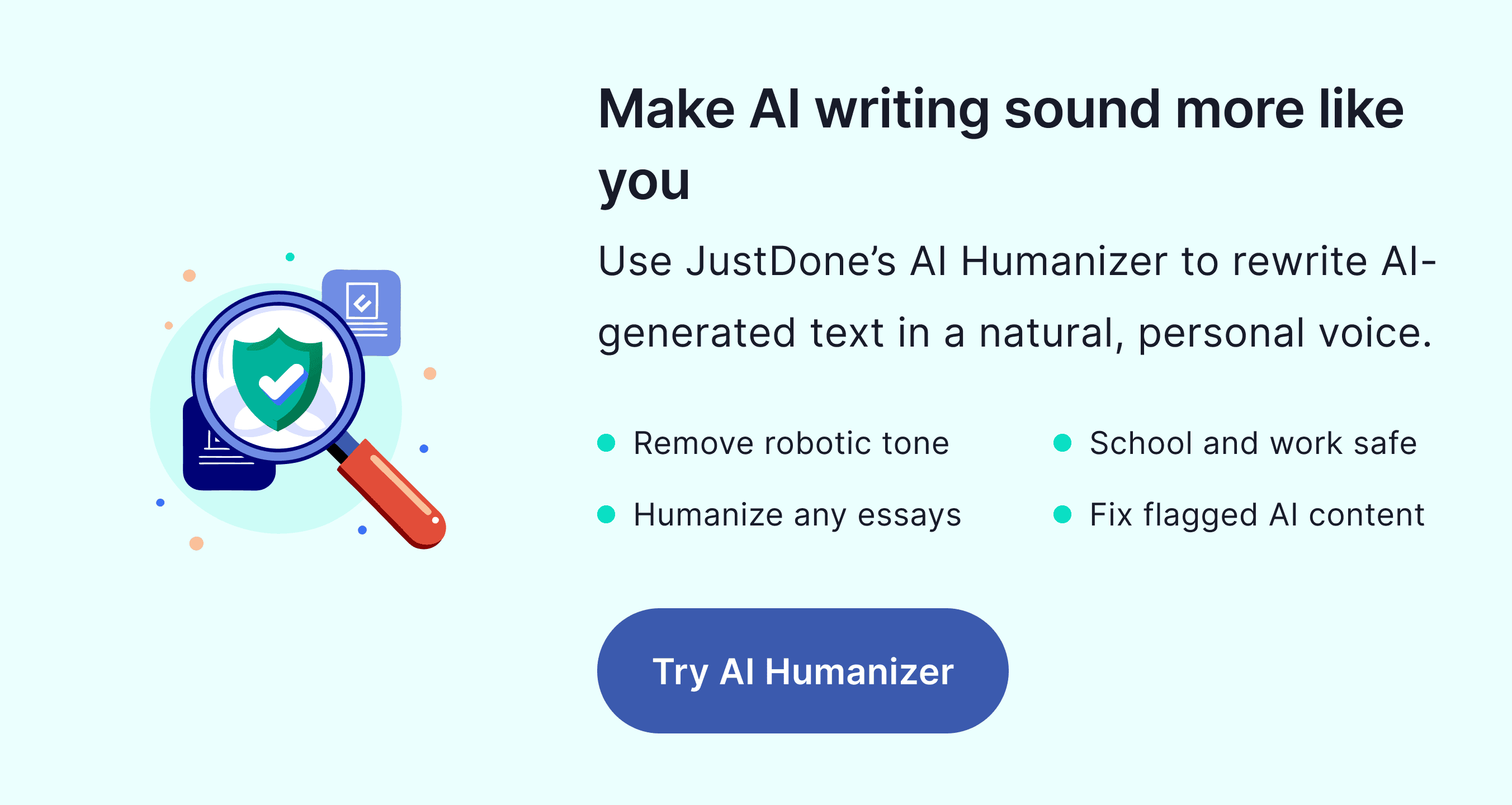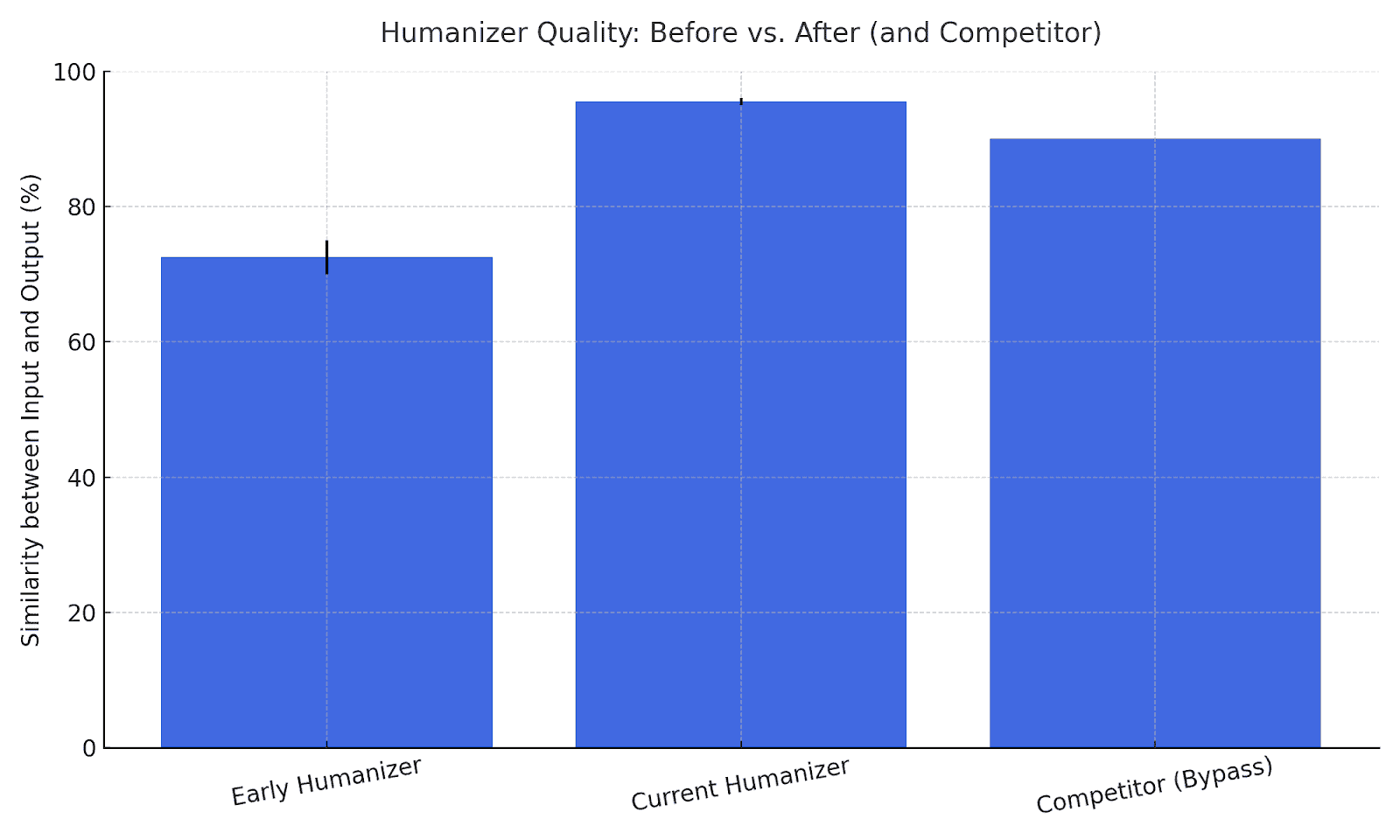Recent data from Business Insider shows that 80-90% students use AI for schoolwork in 2024-2025. ChatGPT, Gemini, Jasper, and other LLMs are good for drafting essays, cover letters, captions, and academic papers. The problem is that they are easily detected by AI checkers. If you can't remove AI patterns from your writing and often get flagged, use AI humanizers.
In this guide, I’ll try to unpack how accurate is AI humanizer. You'll learn how accuracy is measured, what the most accurate AI humanizer tools are, how to judge humanization quality, and whether AI really beats human intuition.
Let’s get straight into the numbers, myths, and decisions that could save your grade or your job.

What Academic Accuracy Means
When you're writing for school or work, content means you’re not just saying something. You should own the text you write and share with others. If your essay or proposal gets flagged as AI-generated, it can damage your credibility. That’s why AI humanizer accuracy is a must-have part of the academic process.
For students, high accuracy means peace of mind. For professionals, it can mean passing through filters and avoiding rejections.
How AI Humanizer Accuracy Is Measured
To know which tool is the most accurate AI humanizer, let's learn what “accuracy” means. Their accuracy depends on how well they can transform detectable AI content into natural. That starts with what’s called the AI humanizer success rate. It's a number that tells you how many AI-flagged texts become “safe” after being humanized. A 94% success rate, for example, means that 94 out of 100 texts passed undetected after humanization.
But success rate alone isn’t enough. Another key factor is how many iterations it takes to pass detection. A tool that gets it right the first time is clearly more effective than one that requires multiple rewrites. Then there’s how well the tool preserves the original meaning of the content. Humanizing shouldn’t scramble your ideas; it means preserving your tone and intent while making it undetectable. Finally, a tool’s compatibility with different AI detectors matters. Some humanizers perform well against GPTZero but fail against Turnitin or Originality.ai. So the question shifts from “how accurate is AI humanizer?” to “how accurate is it for the detection tool you’re worried about?”
The Most Accurate AI Humanizer
I’ve gathered data from the best AI humanizers in 2025 and can provide you with a side-by-side comparison of their success rates and best use cases.
| Tool | Success Rate | Best For | Detector Bypass Strength |
|---|---|---|---|
| Undetectable.AI | 94% | Long-form academic content | Turnitin, GPTZero, Copyleaks |
| QuillBot Humanizer | 76% | Readability & clarity preservation | GPTZero, moderate success on Turnitin |
| JustDone Humanizer | 89% | Custom prompt integration & tone | Excellent across all detectors |
| Humanize AI Tool | 67% | Social media and email content | Originality.ai, CopyLeaks |
| Smodin Humanizer | 58% | Short-form paraphrasing | Limited to simpler detection models |
One of the most important is the quality of the tool's updates. In 2025, after student feedback, JustDone's Humanizer was retrained to better match academic tone. The early version kept only 70-75% of the originla wording and often changed key terms or mishandled rare words. The new version saves 95% of the text, while most competitors are around 90%. The focus of JustDone's updates was on the author's meaning and vocabulary, so the tool makes only necessary changes.

Besides, the best AI humanizer not only has the best success rate. Your tool should also be compatible with the detector your content is likely to face. Turnitin, for instance, remains the hardest detector to bypass in academic settings. Learn more about detector behavior in our article on how AI detectors work.
Challenges of Humanizing AI Text
Not all writing is equally easy to humanize. Creative writing and marketing content often allow more flexibility. You can play with tone, vary sentence structure, and be expressive: all these are elements that help humanizers do their job better. But academic or legal writing? That’s another story.
In academic settings, writing must follow a strict structure, include citations, and use precise vocabulary. This rigidity makes it harder to humanize because even slight changes can affect clarity or meaning. That’s why machine-learning-based humanizers like JustDone work best here. They understand the patterns well enough to keep the core intact while adapting the surface.
Length also plays a role. It’s easier to fix a 200-word caption than a 2000-word thesis. Longer texts introduce more patterns, which detectors latch onto. This is where tools trained with large language models excel, because they handle complexity better.
The AI model used to generate the original content matters too. ChatGPT-4 tends to write in a tighter, more logical structure, making it harder to detect. ChatGPT-5.0 is even harder to detect (if promted right, of course). Gemini, on the other hand, is a bit more flexible, giving humanizers more to work with.
Content generated by the JustDone Generator is already optimized to be more human-like, especially when using thoughtful prompts, which makes the humanization step smoother and more effective.
Is AI Better Than Human ?
Frankly speaking, AI doesn’t replace human thinking. However, it boosts writing significantly. AI is faster and more consistent, but it’s not better than human logic and abstract thinking. What it does brilliantly is optimize workflow. If you’re working against a deadline, AI can draft, outline, or summarize your ideas in seconds. But the final voice should still be yours.
Humanizer tools exist to make AI more helpful, not to replace your input entirely.
When you combine AI’s structure with your creativity and critical thinking, you end up with polished, powerful content that still feels like it came from you. That’s the real win. Especially when you start with smart prompts from tools like JustDone’s content generator. You’re not just writing faster, you’re writing smarter.
Student Writing: Before & After AI Humanization
Let’s look at some realistic examples that students might encounter, like an essay intro, a scholarship motivation paragraph, and a research summary. We’ll walk through how AI-generated outputs get humanized by top tools.
Look at this essay introduction, generated by ChatGPT-5.0:
“Technology has changed many aspects of life. One important area is education. With the use of artificial intelligence, students can learn more effectively. This paper will examine the benefits and challenges of AI in education.”
After humanization using JustDone AI Humanizer with an 89% success rate, it can look far less robotic and more personal:
“From personalized learning to automated feedback, artificial intelligence is reshaping education in real-time. In this essay, I’ll explore how AI is transforming the way students study—and what challenges come with it.”
As you can see, AI humanizer offers more varied sentence structure (burstiness), clearer voice and tone shift, natural transitions and rhythm, and a more engaging hook.
If you’re working on a scholarship motivation letter, you can have the following result generated by Gemini:
“I am a hardworking and passionate student. I want to study computer science because it is interesting. I believe this scholarship will help me succeed and contribute to society.”
However, after humanization by QuillBot Humanizer with a 76% success rate, this paragraph can really be a thing:
“Driven by curiosity and commitment, I’ve always sought to understand how technology shapes our world. Pursuing computer science isn’t just a goal; it’s a path to creating real solutions. This scholarship would support not only my studies but also my mission to make a meaningful impact.”
Obviously, AI humanizer added more emotional tone, eliminated generic phrases, improved flow, and specificity that made the paragraph sound more like an actual student narrative.
Quality Control Tips After AI Humanization
Even the most accurate AI humanizer won’t do everything for you. Once you’ve run your text through a tool like JustDone AI humanizer, you’re not quite finished. You need to check that your final version doesn’t just pass a detector; it should also make sense, sound like you, and stay true to your ideas.
Start by reading your text out loud. This might sound awkward, but it works. If a sentence feels AI or unclear, it needs a small edit. Your voice is the key to making the writing believable.
Next, try running your final version through more than one AI detector. Don’t just trust the one the humanizer was designed to beat. For example, a tool might bypass GPTZero, but Turnitin could still flag it. Try JustDone’s detector first, then test it again using Originality.ai or even Copyleaks if your school uses them. Think of it as running a final spellcheck, except for AI patterns.
If a detector does flag something, don’t panic. Go back to that part of the text. Ask yourself: Is this too robotic? Is it too symmetrical? Could it use a more personal touch? A small rewrite, like adding an opinion, anecdote, or varied sentence length, can go a long way.
Also, look at structure and citations. When AI humanizers tweak your writing, there’s a small risk of accidentally deleting or changing important points. If you're writing an academic piece, double-check that your citations are still correct and that your conclusion still connects to your thesis. Don’t lose your argument just to sound more human.
For tone, use JustDone's AI humanizer to smooth out your writing so it sounds confident and natural.
Lastly, save every draft. If you’re ever asked to prove that you wrote something yourself, have earlier versions, brainstorm notes, or Google Docs revision history. Teachers don’t just want to know what you wrote; they want to know how you wrote it.
Need extra help? See more hands-on tips to humanize AI content.
Final Thoughts: Humanized to Win
The future of writing is linked to the question of how to humanize AI content. Whether you're a student avoiding flags on Turnitin or a content creator passing editorial checks, accuracy matters.
Choose the right tool, understand your content's unique needs, and never settle for one-size-fits-all AI. If you're serious about seamless writing and stay undetected, start with tools that are built for the job, like the JustDone AI Humanizer.